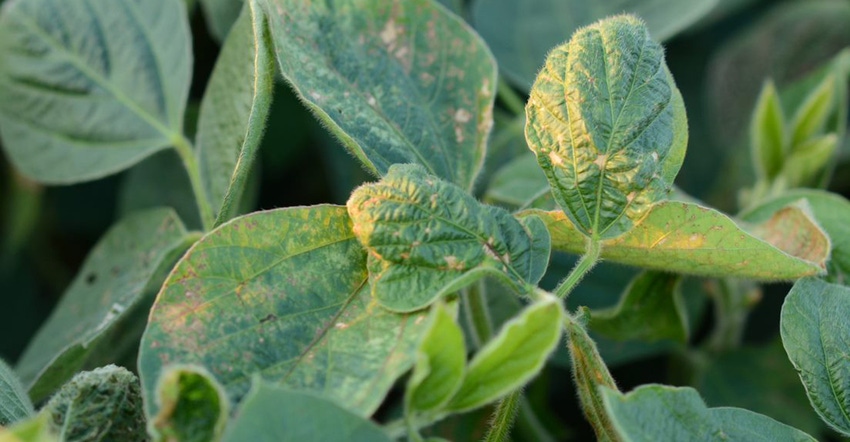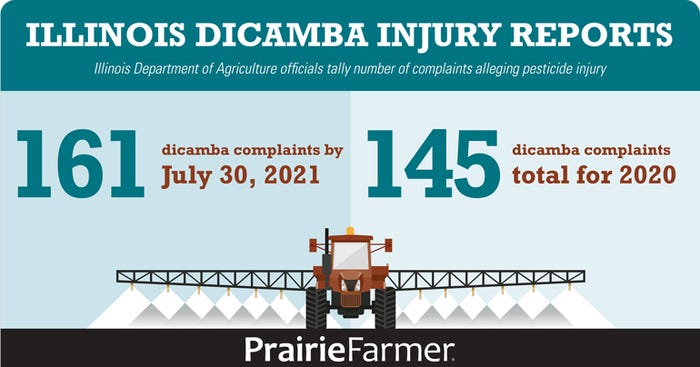
Are you seeing more dicamba damage than last year, despite application cutoff dates and temperature restrictions? You are not alone.
The Illinois Department of Agriculture has received 273 ag-related herbicide misuse complaints as of July 30. Of those, 161 are related to off-target dicamba damage — a midseason number that’s higher than the total 145 complaints the department received in 2020.
Related: Dicamba 101: What you need to know for 2021
Much of Illinois agriculture hailed 2020 as a win for dicamba control, and farmers, regulators and industry alike hoped 2021 might follow suit. For reference, 2019 saw 723 total dicamba complaints; 2018 brought 330 total dicamba complaints, and 2017 logged 246 total dicamba complaints.
What’s happened to cause the jump in complaints from 2020 to 2021?
Currently, IDOA is investigating damage claims, in an attempt to confirm the primary causes of dicamba complaints, says Brad Beaver, acting bureau chief of environmental programs.
“We’ve heard people complain about some of the corn products causing some damage. The complaint forms that have come in have mentioned volatilization as a cause,” he says. “Other forms are looking at straight particle drift, some without authorization and then drift based off of that.”
Before soybeans and cotton were able to be sprayed with dicamba in-season, farmers did not have as many dicamba damage complaints, says Karen Corrigan, agronomist and partner in McGillicuddy Corrigan Agronomics. So, those commodities tend to be looked at as the villains. However, plenty of other factors may be at fault.
Corrigan shares other culprits to consider:
Corn application. Unlike soybean application, a temperature cutoff does not exist for corn application, and higher temperatures boost volatility. Labels allow dicamba application on corn up until stage V10, or 36 inches, which is well into the soybean growing season.
Contamination. Contamination can come from dicamba that did not get cleaned out properly. Dicamba can also seep out of hoses, plastic pieces and poly tanks when herbicides such as Roundup are left overnight or longer in the tanks. According to EPA, dicamba contaminants are allowed in 2,4-D, but must be reported above 250 parts per million. Bill Johnson, Purdue University, recently shared on Twitter that generic 2,4-D, often used on Enlist beans, can contain up to 250 ppm of dicamba. He added it takes less than 100 ppm to cause cupping symptoms.
Air temperature inversions. Temperatures over 90 degrees F in Illinois help create more mist and fog, which indicate a temperature inversion. Ultimately, inversions help dicamba vaporize and move across fields and large distances.

Moving forward
No matter the cause of increased dicamba complaints in 2021, Corrigan says farmers should think about product options for 2022.
“It’s important to remember that XtendiMax, Tavium and Engenia are all still involved in a court case with the environmental groups,” she says. “At any point after oral arguments are completed, those could be pulled off the market.”
She recommends farmers secure herbicides first and then traits. And choose a trait with multiple herbicide options. She adds that conventional herbicides such as Roundup are still a good option for any trait.
IDOA regulations for 2022 may also influence product selection. The dicamba application restrictions put into effect for 2021 were under emergency rule and will expire before next growing season, Beaver says. He says they’ll announce updates in time for farmers to make input decisions.
He says discussions have begun with weed scientists and counterparts in other states to determine if the regulations of 2021 will become permanent. An EPA review and any potential proposals will also affect decisions.
About the Author(s)
You May Also Like






